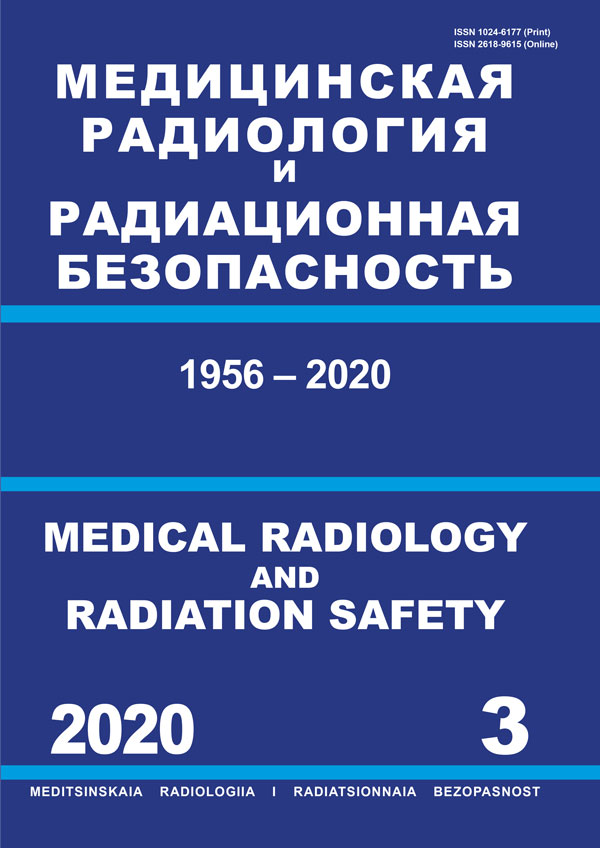CSCSTI 34.39
CSCSTI 34.49
Purpose: To study the possibility of using radiopharmaceutical (RPH) Sodium fluoride, 18F (Na18F) in order to identify the characteristics and dynamics of the development process for a number of non-neoplastic lesions in bone tissue such as fractures and osteoporosis in experimental animals by the method of positron emission tomography (PET). Material and methods: Two experimental models of pathology of bone tissue in rats were used: fracture and osteoporosis. The model of osteoporosis was created by intraperitoneal introduction of hydrocortisone during 3 weeks. The study was conducted in 22 days from the onset of the agent introduction. In areas of the chest and sacral sections of the spinal cord in experimental and intact animals we detected the value of uptake of Na18F, as well as indices of tissue density with data of X-ray CT. In the model of fracture of bones injury struck in the pre-anesthetized rats in the region of the shin. Animals were examined starting from the 3rd day up to the 30th day after the fracture by PET and PET/CT. We detected the value of uptake, the dynamics of Na18F accumulation, as well as indices of densitometry and signs of callus formation with CT examination. Results: In rats with osteoporosis compared with intact animals observed a 2,5-fold decrease of the bone tissue density in X-ray, whereas the level of metabolic activity in the bones of the PET scan with Na18F was 5.6 times lower than in healthy rats. Therefore, differences in the level of capture of the radiopharmaceutical in PET were significantly more important compared to the ratio of the values of the X-ray of the bone tissue density, determined by CT. In experiments with shin fracture was noted hyperfixation and increasing rate of Na18F accumulation on PET-scans since the 9th and 30th day from the start of the experiment. It reflects a process of enhancing the metabolism in the injured area. At the same time, a significant increase of densitometric density and visualisation of callus formation in the fracture by CT were detected 3 weeks later, – only by the 30th day after trauma. Conclusion: The use of Na18F in positron-emission tomography enables to diagnose more early and accurate the nature (osteoporosis) and intensity of processes of the restoration (fracture) in the injured bone tissue as compared to results of computed tomography.
radiopharmaceutical, positron emission tomography, osteoporosis, bone fracture, animals
РФП «Натрия фторид, 18F» (Na18F) признан оптимальным для исследования костей методом позитронно-эмиссионной томографии (ПЭТ) [1–3]. Отсутствие связывания фтор-иона с белками сыворотки крови [4–6], быстрая экскреция с мочой [7], локализация в остеообразующих зонах костей и костных метастазах опухолей [4, 8] в сочетании с высокой разрешающей способностью ПЭТ обеспечивает преимущество Na18F перед другими РФП. Задача данной экспериментальной работы состояла в выяснении возможности и целесообразности использования ПЭТ с Na18F при исследовании повреждений костной ткани неопухолевой этиологии, а также для установления характера и динамики течения патологического процесса.
1. Blau M., Nagler W., Bender M.A. Fluorine-18: a new isotope for bone scanning // J. Nucl. Med. 1962. Vol. 3. P. 332-334.
2. Blau M., Ganatra R., Bender M.A. 18F-fluoride for bone imaging // Semin. Nucl. Med. 1972. Vol. 2. P. 31-37.
3. Langsteger W., Heinisch M., Fogelman I. The role of fluorodeoxyglucose, 18F-dihydroxyphenylalanine, 18F-choline, and 18F-fluoride in bone imaging with emphasis on prostate and breast. // Semin. Nucl. Med. 2006. Vol. 36. P. 73-92.
4. Weber D.A., Greenberg E.J., Dimich A. et al. Kinetics of radionuclides used for bone studies // J. Nucl. Med. 1969. Vol. 10. P. 8-17.
5. Wootton R., Dore C. The single-passage extraction of 18F in rabbit bone // Clin. Phys. Physiol. Meas. 1986. Vol. 7. P. 333-343.
6. Carlson C.H., Armstrong W.D., Singer L. Distribution, migration and binding of whole blood fluoride evaluated with radiofluoride // Amer. J. Physiol. 1960. Vol. 199. P. 187-189.
7. Costeas A., Woodard H.Q., Laughlin J.S. Depletion of 18F from blood flowing through bone // J. Nucl. Med. 1970. Vol. 11. P. 43-45.
8. Hawkins R.A., Choi Y., Huang S.C. et al. Evaluation of the skeletal kinetics of fluorine-18-fluoride ion with PET // J. Nucl. Med. 1992. Vol. 33. P. 633-642.
9. Guidelines for working with laboratory animals for the staff of the N.I. Pirogov Russian National Research Medical University engaged in conducting preclinical trials. - Moscow. 2015. 42 pp.
10. The Russian State Standard (GOST) R 53434-2009 “Principles of good laboratory practice”. - Moscow. 2010. 28 pp.
11. The order No. 119n dated April 1, 2016 of the Ministry of Health and Social Development of the Russian Federation “On approval of rules of good laboratory practice”. - Ministry of Health of the Russian Federation. 2016.
12. Hellwig D., Krause B.-J., Schirrmeister H., Freesmeyer M. Skelettdiagnostik Mittels 18F-Natriumfluorid-PET und PET/CT // Nuklearmedizin. 2010. Vol. 5. P. 195-201.





